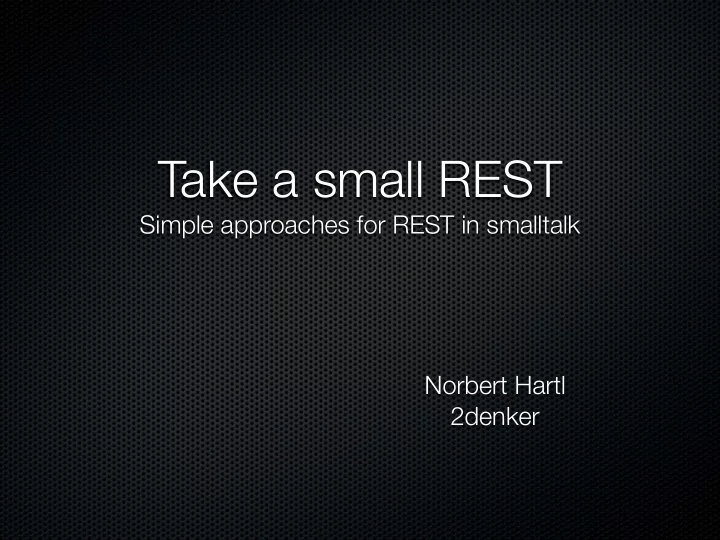

Take a small REST Simple approaches for REST in smalltalk Norbert Hartl 2denker
What we do... ...at 2denker mobile applications backend services for mobile applications backend services for b2b
Why REST? there are RPC-style services (SOAP , XML-RPC,...)
Why REST? there are RPC-style services (SOAP , XML-RPC,...) REST is data-centric
Why REST? there are RPC-style services (SOAP , XML-RPC,...) REST is data-centric REST/HTTP has meta data
Why REST? there are RPC-style services (SOAP , XML-RPC,...) REST is data-centric REST/HTTP has meta data REST is about identity
Smalltalk tools to do REST Magritte Magritte-XMLBinding Magritte-JSON Seaside-REST
serialization/materialization using magritte meta tool support model with meta information validation of model using meta information conversion into/from formats with meta info
Example class Person fullName emailAddress
model with meta information Person>>#fullNameDescription <magritteDescription> ^ MAStringDescription new accessor: #fullName; label: 'full name'; beRequired; priority: 100; yourself
model with meta information (using pragma to add a description) Person>>#fullNameDescription < magritteDescription > ^ MAStringDescription new accessor: #fullName; label: 'full name'; beRequired; priority: 100; yourself
model with meta information (adding type information) Person>>#fullNameDescription <magritteDescription> ^ MAStringDescription new accessor: #fullName; label: 'full name'; beRequired; priority: 100; yourself
model with meta information (specifying value store/retrieve operation) Person>>#fullNameDescription <magritteDescription> ^ MAStringDescription new accessor: #fullName ; label: 'full name'; beRequired; priority: 100; yourself
validation using meta info (magritte) Person>>#emailAddressDescription <magritteDescription> ^ MAStringDescription new accessor: #emailAddress; label: 'email address'; addCondition: [:val| val includes: $@ ] labelled: 'address must contain @'; beRequired; priority: 200; yourself
validation using meta info (magritte) Person>>#emailAddressDescription <magritteDescription> ^ MAStringDescription new accessor: #emailAddress; label: 'email address'; addCondition: [:val| val includes: $@ ] labelled: 'address must contain @'; beRequired; priority: 200; yourself
validation using meta info (magritte) Person>>#emailAddressDescription <magritteDescription> ^ MAStringDescription new accessor: #emailAddress; label: 'email address'; addCondition: [:val| val includes: $@ ] labelled: 'address must contain @'; beRequired; priority: 200; yourself
adding conversion info (for Magritte-XMLBinding) fullNameXmlDescription: aDescription <magritteDescription: #fullNameDescription> ^ aDescription xmlElementName: 'fullname' emailAddressXmlDescription: aDescription <magritteDescription: #emailAddressDescription> ^ aDescription xmlAttributeName: 'email'
conversion into/from format p := Person new. p fullName: 'John Doe'; emailAddress: 'john@doe.it'. p magritteDescription toXml: p <Person email="john@doe.it"> <fullname>John Doe</fullname> </Person>
REST call flow message routing and parameter handling content type selection serializiation/materialization to/from network data
message routing time <get> <path: '/time'> self requestContext response status: 200; nextPutAll: Time now greaseString; respond
message routing (matching HTTP verb) time <get> <path: '/time'> self requestContext response status: 200; nextPutAll: Time now greaseString; respond
message routing (matching path/parameters) time <get> <path: '/time'> self requestContext response status: 200; nextPutAll: Time now greaseString; respond
content type xml getPersonXml: aString <get> <path: '/person/{1}'> <produces: 'application/xml'> self requestContext response status: 200; nextPutAll: ( self description toXml: (self personWithId: aString)); respond
content type xml (placeholder in url become method paramter) getPersonXml: aString <get> <path: '/person/ {1} '> <produces: 'application/xml'> self requestContext response status: 200; nextPutAll: ( self description toXml: (self personWithId: aString)); respond
content type xml (content type selection based on Accept header) getPersonXml: aString <get> <path: '/person/{1}'> <produces: 'application/xml'> self requestContext response status: 200; nextPutAll: ( self description toXml: (self personWithId: aString)); respond
content type json getPersonJson: aString <get> <path: '/person/{1}'> <produces: 'application/json'> self requestContext response status: 200; nextPutAll: (String streamContents: [:stream| (self personWithId: aString) jsonOn: stream]); respond
example post addPersonFromJson <post> <path: '/person'> <consumes: 'application/json'> self addPersonUsing: [ self materializeFromJson ]
example post (content type selection based on Content-Type header) addPersonFromJson <post> <path: '/person'> <consumes: 'application/json'> self addPersonUsing: [ self materializeFromJson ]
Demo
Thank you! Questions?
Recommend
More recommend